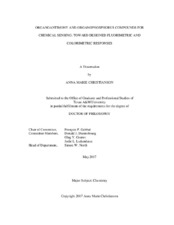| dc.description.abstract | The design of molecular chemical sensors has generally relied on the use of colored and/or luminescent organic dyes or transition metal complexes; however, recent advances have been made in the use of heavy main group elements such as phosphorus, selenium, antimony, and tellurium as functional elements in sensors. We have become interested in the use of heavy Group 15 elements for sensing, especially Lewis acidic organoantimony(V) derivatives, which may be used for the selective sensing of fluoride anions in water. Building upon our previous work, we have now developed a series of heavy Group 15-incorporating compounds featuring improved photophysical properties including visible-wavelength absorption and high quantum yield emission, sensitivity to a wider range of analytes for sensing, and a diverse manifold of sensing response mechanisms based on chemistry at the main group element. We have focused on uncovering these mechanisms through structural analysis and spectroscopic characterization supported by DFT computational methods, in order to gain understanding of the link between analyte recognition at the Group 15 element and the observed photophysical change.
To this end, we have synthesized and characterized antimony(III)- and antimony(V)-substituted derivatives of highly fluorescent BODIPY and fluorescein dyes, as well as intensely colored ruthenium polypyridyl complexes. The Lewis acidic Sb(V)-decorated BODIPY displays a “turn-on” fluorescent response to both fluoride and cyanide anions, while the Sb(III)-decorated fluorescein derivative functions as a “turn- off” sensor for peroxide. The Sb(V)-substituted ruthenium polypyridyl complex also responds to fluoride and cyanide anions, with a response that is observable both colorimetrically and electrochemically. A phosphorus-decorated fluorescein derivative has also been developed as a “turn-on” fluorescent sensor for gold(III) ions in aqueous solution, which is functional at nanomolar concentrations of gold. Finally, a series of Sb(III)- and Sb(V)-incorporating heterocycles have been developed that feature direct interaction of antimony-based σ* orbitals with the organic π system. In these compounds, the incorporation of antimony within the π-conjugated structure provides direct control over the photophysical properties, which holds promise for the design of anion sensors as well as color-tunable materials. | en |


